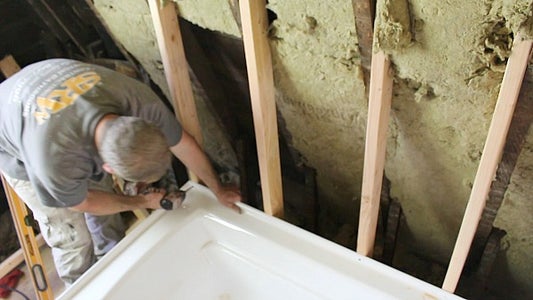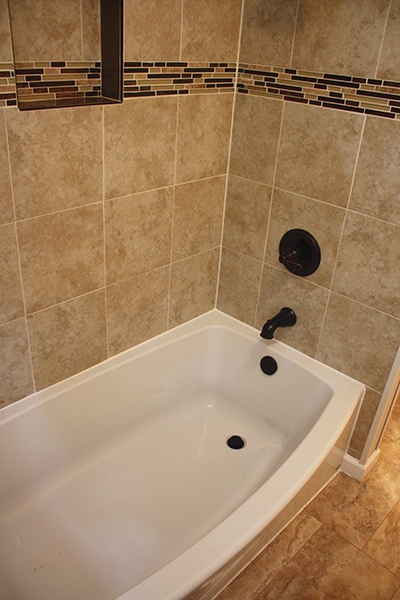Have you been hunting for guidance about How to Install a Bathtub?

Setting up a bathtub isn't specifically rocket science, yet it does need solid plumbing, woodworking, as well as in some cases, tiling abilities. Changing an old bathtub with a brand-new one is likewise a moderately hard job. If the old tub is conveniently available, the project can relocate quickly; if you need to open up a wall to get rid of the old tub and also position the brand-new tub, the task is a lot harder. In either case, the task is within a home handyman's abilities, although you will require a helper to vacate the old tub and embeded in the new one. Make certain you have actually qualified on your own for the job as well as are comfortable trying it. Rather than employing a contractor to take control of a halfway-completed project, it is much better to consider utilizing one prior to you begin. Opportunities are you might need a specialist plumber to make tube connections.
This post will aid you install a brand-new bathtub in your restroom if you have actually already gotten a new tub and also don't require to transform the arrangement of your previous water system pipelines.
Your tools as well as product checklist must consist of the following:
Getting ready for the Installment
First of all, the sustaining frame provided with the bathroom ought to be fitted (if called for) according to the manufacturer's guidelines. Next off, fit the taps or mixer to the tub. When suitable the tap block, it is very important to make sure that if the tap features a plastic washer, it is fitted between the bath as well as the faucets. On a plastic bathroom, it is also sensible to fit a supporting plate under the faucets device to stop strain on the bathtub.
Fit the versatile faucet adapters to the bottom of both faucets using 2 nuts and olives (in some cases provided with the bathtub). Fit the plug-hole electrical outlet by smearing mastic filler round the sink electrical outlet opening, and then pass the electrical outlet through the hole in the bath. Use the nut supplied by the producer to fit the plug-hole. Take a look at the plug-hole electrical outlet for an inlet on the side for the overflow pipeline.
Next off, fit completion of the adaptable overflow pipeline to the overflow electrical outlet. Afterwards, screw the pipe to the overflow face which should be fitted inside the bathroom. See to it you make use of every one of the provided washing machines.
Attach the trap to the bottom of the waste outlet on the tub by winding the thread of the waste outlet with silicone mastic or PTFE tape, as well as screw on the trap to the outlet. Connect the bottom of the overflow tube in a similar manner.The bath should now be ready to be suited its last placement.
Removing Old Touches
If you require to change old taps with new ones as a part of your setup, then the first thing you should do is disconnect the supply of water. After doing so, turn on the taps to drain any kind of water continuing to be in the system. The procedure of eliminating the existing faucets can be rather problematic due to the limited gain access to that is frequently the case.
Use a container wrench (crowsfoot spanner) or a faucet device to undo the nut that connects the supply pipelines to the faucets. Have a fabric ready for the remaining water that will certainly originate from the pipes. Once the supply pipes have actually been eliminated, utilize the same device to loosen the nut that holds the faucets onto the bath/basin. You will require to quit the single faucets from turning throughout this process. Once the faucets have been gotten rid of, the holes in the bath/basin will need to be cleaned up of any old securing compound.
Prior to proceeding to fit the brand-new taps, contrast the pipe links on the old faucets to the brand-new taps. If the old taps are longer than the new taps, then a shank adapter is needed for the brand-new faucets to fit.
Mounting the Bath tub
Using the two wooden boards under its feet, position the bath tub in the required setting. The wood boards are handy in evenly spreading the weight of the tub over the location of the boards as opposed to focusing all the weight onto four small points.
The next goal is to make certain that the bathtub is leveled all round. This can be accomplished by inspecting the level and changing the feet on the bath tub till the spirit level checks out degree.
To mount faucets, fit the bottom of the outermost versatile faucet connector to the ideal supply pipe by making a compression sign up with; then do the very same for the various other tap.
Activate the water as well as examine all joints as well as new pipework for leakages and tighten them if essential. Fill up the bathtub as well as also examine the overflow outlet and also the regular electrical outlet for leaks.
Ultimately, take care of the bath paneling as described in the maker's instruction manual. Tiling and also securing around the bathtub needs to wait up until the bath tub has been used at least when as this will certainly settle it right into its last setting.
Fitting New Touches
If the tails of the new taps are plastic, after that you will need a plastic adapter to stop damages to the thread. One end of the connector fits on the plastic tail of the tap and also the various other end supplies a connection to the existing supply pipes.
If you require to fit a monobloc, after that you will require reducing couplers, which attaches the 10mm pipeline of the monobloc to the basic 15mm supply pipe.
Next off, place the tap in the mounting opening in the bath/basin ensuring that the washing machines remain in location between the faucet and the sink. Secure the tap in place with the supplier supplied backnut. When the tap is safely in place, the supply pipes can be connected to the tails of the faucets. The faucets can either be linked by using corrugated copper piping or with normal faucet adapters. The former type should be attached to the faucet ends first, tightening up just by hand. The supply pipes can later be connected to the various other end. Tighten up both ends with a spanner after both ends have actually been linked.
Tiling Around the Bathtub
In the location where the bath meets the floor tile, it is needed to seal the accompanies a silicone rubber caulking. This is very important as the fitting can move sufficient to break a rigid seal, creating the water to permeate the wall in between the bathroom and the tiling, bring about issues with dampness and also feasible leaks to the ceiling listed below.
You can select from a variety of coloured sealers to blend in your fixtures and installations. They are marketed in tubes as well as cartridges, and can securing spaces up to a size of 3mm (1/8 inch). If you have a larger gap to load, you can load it with twists of drenched paper or soft rope. Keep in mind to always load the tub with water before securing, to enable the movement experienced when the bathtub is in usage. The sealer can crack rather early if you do not consider this activity prior to sealing.
Conversely, ceramic coving or quadrant ceramic tiles can be used to border the bath or shower tray. Plastic strips of coving, which are easy to use and also cut to dimension, are likewise easily readily available on the market. It is suggested to fit the ceramic tiles using waterproof or waterproof sticky and cement.
Bathtub Installation
How Important Is A Bathtub To Your Home?
High-quality baths, showers, and other bathroom updates are necessary when considering a smart investment in your home. It’s a room that you go to every day and one that is constantly being used by guests.The bathroom is one of the top trafficked rooms in a home and also one of the most valuable in terms of home resale.
Install Piping Before Tub
You will be using your existing drain and waste vent system, but pipes required include the hot and cold water supply lines and a pipe leading to a shower head. A mixing valve and shower head are also needed. Air chambers may be required.
Position the Tub
Lower the tub into place so that the continuous flange fits against the wall studs and rests on 1’x4' or 2’x4' supports. Anchor the tub to the enclosure with nails or screws inserted through the flanges into the studs.
NOTE: Remember, bathtubs and shower stalls may require support framing. A bathtub filled with water is extremely heavy, so check building codes and framing support before installing the tub.
Assemble Drain Connections
Assemble the bathtub drain connections by connecting the tub overflow with the tub drain above the trap, not beyond it. The trap will have a compression fitting that screws over the arm of the overflow assembly.
Place a Pipe For the Shower Head
First, locate a brass female threaded winged fitting and attach it to a framing support via a screw or a nail. Then run a pipe up the wall for the shower head. Sweat or solder the other side of the brass fitting to the top of the pipe.
Attaching Hot and Cold Water Lines
Attach your water lines for both hot and cold by sweating these directly into the hot and cold ports of the mixing valve. The mixing valve will be how water enters the tub’s system, not by the pipes themselves.
Install the Spout
Extend a piece of 1/2 inch pipe, or whichever length is specified in the manufacturer’s instructions, for the tub spout. Sweat on a male threaded fitting at the end of the pipe or use a brass nipple of the proper length and a 1/2 inch cap.
NOTE: At this point you should have your rough-in plumbing work inspected before proceeding further.
Check For Leaks
Restore the water pressure and check the drain connection and the supply pipes for any sign of leaking.
estore the Bathroom Wall
Replace the wall with moisture-resistant drywall as a base for your wall covering. Seal the joints between the wall and your new tub with silicone caulk as protection against water seepage.
https://www.berkeys.com/2016/12/02/bathtub-installation-dallas/

As a serious person who reads on How to Install a Bathtub Yourself, I imagined sharing that excerpt was sensible. Those who enjoyed reading our blog entry kindly don't forget to pass it around. Thank you for taking the time to read it.
Make An Appointment